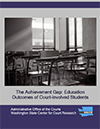Published:
Executive Summary
This study explores education outcomes of students who were enrolled in 8th or 9th grade in Washington state public schools during the 2010-2011 academic year (AY10-11) and who were involved in one or more juvenile court cases that year. All juvenile court cases were categorized into three main categories: 1) juvenile delinquency cases, 2) juvenile dependency cases, and 3) status offense cases (see the sidebar for definitions). These students were followed over a period of five years after their court involvement to allow for examination of high school outcomes and postsecondary enrollment. The study comparison group was the remainder of 8th or 9th graders who were not involved with the juvenile court during AY10-11.
The study found that court-involved students differed from court non-involved students in many observable ways. In particular, students who came into contact with the court systems disproportionally experienced adverse social, economic, and physical conditions such as poverty, housing instability, school mobility, special education needs, and in-school disciplinary sanctions. For many court-involved students, these adverse conditions were evident since 6th or 7th grade, i.e., two years prior to their court involvement. Regardless of court involvement, these students were at a heightened risk for not graduating.
In regard to education outcomes, we found that court-involved students underperformed on most markers of educational achievement compared to their court non-involved peers. Yet, the type of court involvement mattered. Students involved in multiple types of court cases during the same school year fell even further behind academically compared to students who were involved in only one type of juvenile court cases.
Key findings include:
Court-involved students, as a group, were more likely than their court non-involved peers to be boys (61% vs 51%), include a far larger percentage of minority students (50% vs 37%), and come from families with limited financial resources1 (88% vs 46%).
Court-involved students were less likely to graduate from high school (20%) compared with their court non-involved peers (74%). Of those court-involved students who graduated, 19% had delayed graduation, as oppose to only 5% students in the comparison group.
Court-involved students were more likely to drop out (53%) than their court non-involved counterparts (13%).
The rate at which court-involved students earned a GED certificate (13%) exceeded the rate of students in the comparison group (2%).
College enrollment (for both 2-year and 4-year colleges combined) was lower among court-involved students (37%) than their court non-involved peers (54%). The gap in college enrollment was particularly large for 4-year colleges. Only 2% of court-involved students attending a postsecondary institution were enrolled in a 4-year college as opposed to 28% of court non-involved students.
Even after controlling for student demographics, differences in service needs, and previous academic performance, the study found that court involvement, on its own and regardless of court case type, was a predictor of whether a student would graduate, dropout, or earn a GED.
However, after accounting for the type of court cases, some types of court involvement were no longer predictive of high school graduation, dropout, or GED:
Being involved in a delinquency case(s), non-offender case(s) or in multiple types of court cases significantly decreased student’s chances to earn a high school diploma and significantly increased the chances of dropout. Exposure to multiple case types had the strongest effect on students' tendency to graduate or drop out. Being involved in a dependency case was not found to be significant in predicting of high school graduation or dropout status.
Only involvement in a delinquency court case(s) or non-offender case(s) increased the chances that a court-involved student would earn a GED. Dependent students and students with multiple court cases were equally likely as their court non-involved peers to earn a GED certificate.
After controlling for students’ background characteristics, differences in service needs, and previous academic performance, court involvement, by itself, did not predict students’ chances of enrolling in a postsecondary institution (both 2-year and 4-year colleges combined). College enrollment was mostly dependent on the applicant possessing a high school diploma or a GED certificate, and academic preparedness (i.e., 9th grade GPA, sufficient credit accumulation in 9th grade, and performance on 10th grade level tests).
An important take-away from this study is that court involvement is associated with higher dropout and lower graduation rates. Earning a high school diploma or having a GED (for students who did not graduate) plays a significant role in determining whether a student will enroll in a postsecondary institution. The fact that only 20% of students involved with the juvenile court in 8th or 9th grade graduated from high school and only 13% earned a GED poses a significant challenge. These findings illustrate importance of searching for new and more effective approaches to improving outcomes for students who are at risk of being involved with the court systems and those who are already involved with the court.


